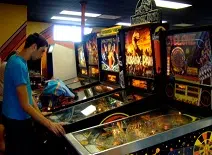 A pinball is a game that is based on the momentum of a ball inside a board equipped with various components. The objective is for the ball to impact different elements to accumulate points , without leaving the field of play.
A pinball is a game that is based on the momentum of a ball inside a board equipped with various components. The objective is for the ball to impact different elements to accumulate points , without leaving the field of play.
Also known as flipper , pimbola , pinbola , milloncete or petacos , pinball can be electronic, mechanical or electromechanical. The game begins when, by the action of a spring , the ball is sent into an inclined board.
There the ball hits different obstacles as it descends. When it reaches the lower sector, the player must prevent it from falling by hitting the ball with paddles activated by buttons .
If you manage to hit the ball, it rises again and bounces against the obstacles again until it descends again. On the other hand, if the ball crosses the line of the paddles without being hit, it falls and leaves the field of play, causing the player to lose.
Pinball machines achieved great popularity from the 1970s to the '90s . They could be found in video game arcades, casinos , bars and other spaces. Over time they lost popularity, although they are still highly valued by collectors.
But the history of pinball may be much longer than people think. To know the origins of this peculiar recreational device we must go back to the 18th century, in France. At that time, the entertainment of aristocrats revolved around croquet; However, since they could not play it during rainy days, a game called bagatelle emerged, a distant ancestor of pinball.
In reality, the bagatelle consisted of a wooden board with several strategically located pivots and a mechanism to launch a ball, which moved across the surface until it became trapped in one of its sections (each one with its respective numerical value that translated in points for the player) or falling on the base (where no points were added).
The success of bagatelle increased when it arrived on the American continent at the time of the Revolution, in the late 1700s. But it would be quite some time before the North American named Montague Redgrave turned this old French game into the first version of pinball. To do this, he requested a patent that allowed him to take it as a base and add some of the changes that differentiate them, such as the spring.
 During the Great Depression, the most serious global financial crisis of the 20th century, the need for cheap entertainment led many people to become interested in pinball. In 1931 the first automatic version appeared, which required a payment in coins to start playing. This change in design was key to its success from then on.
During the Great Depression, the most serious global financial crisis of the 20th century, the need for cheap entertainment led many people to become interested in pinball. In 1931 the first automatic version appeared, which required a payment in coins to start playing. This change in design was key to its success from then on.
However, when the North American government began to perceive pinball as a game of chance, it banned it, and this situation lasted for nearly four decades. Of course, this didn't stop people from continuing to use pinball for fun. In fact, it was during the years of prohibition that Gottlieb incorporated paddles, the element that today we consider basic of any pinball. In 1976, its use became legal again.
Beyond always maintaining the same structure, pinball machines present multiple formats, with images that allow the entertainment to be associated with superheroes , automobile competitions, spaceships, etc. It is possible to find pinballs from “Star Wars” , “Jurassic Park” , “Superman” and “Terminator” , for example.
Virtual pinballs , on the other hand, are digital games that simulate the behavior of the aforementioned machines. One of the most famous is “3D Space Cadet Pinball” , which was part of several versions of the Windows operating system.
